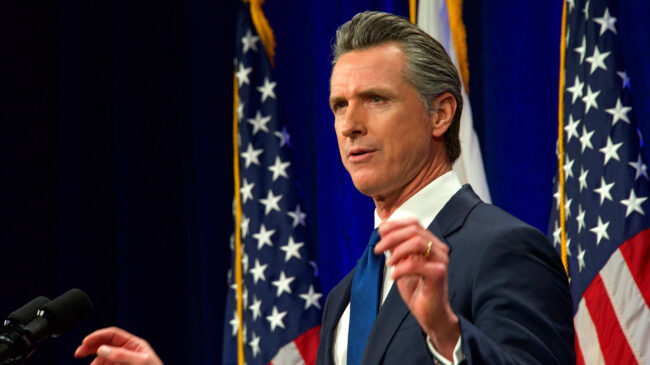Many Californians are understandably baffled by Gov. Gavin Newsom’s 2023-24 proposed budget and the debate surrounding the projected $22.5 billion state budget deficit. Not long ago, California lawmakers were creating a record-setting budget and spending a $100 billion budget surplus.
But last October, Fitch Ratings warned that “tax revenues from July through September 2022 grew at a median rate of 7.6%” year-over-year in other states, “with only California reporting a [year-over-year] decline” in tax revenues. In other words, all 49 other states saw tax revenues increase. Then, in November, California’s nonpartisan Legislative Analyst’s Office predicted a massive state budget shortfall this year because “income tax payments for 2022 so far have been notably weaker than 2021, likely due in part to falling stock prices.”
Newsom’s budget proposal aims to meet California’s balanced budget requirement without drawing from the state’s reserve funds by making some spending cuts along with various deferments. Nevertheless, Republicans like State Sen. Roger Niello, R-Fair Oaks, offered some cautious praise on that front. “Republicans fought to fill the rainy day fund, and we applaud today’s commitment to not tap into it,” Niello said when the budget was unveiled.
The most significant cuts aim to trim the climate change spending package passed last year, upsetting many progressives and climate change activists. “California can’t afford a short-sighted budget,” Mary Creasman, chief executive officer of California Environmental Voters, said. “To further delay these investments will further compound the climate crisis and the cost of inaction will be far worse.”
State Sen. Scott Wiener, D-San Francisco, was similarly concerned about potential cuts to mass transit projects. “While I fully understand the tough choices we have to make, we must not let our public transportation systems go over the impending fiscal cliff and enter a death spiral — where budget shortfalls lead to service cuts that lead to ridership drops that lead to further budget shortfalls and service cuts,” Wiener said.
Wiener is correct: The state must make tough choices. But one easy choice should be to kill the high-speed rail project once and for all. Over 14 years ago, a 2008 high-speed rail due diligence study by Reason Foundation and the Howard Jarvis Taxpayers Foundation found the travel times promised to voters that year were unachievable, the construction timeline was off by decades, and the price would likely rise to over $80 billion in 2008 dollars. Those predictions have all proven true.
The latest cost estimate for the high-speed rail system is $113 billion, the system is still decades away, and the only major construction is in the Central Valley—a far cry from the full San Francisco to Los Angeles system promised voters, and even if it is ever built the system won’t offer true high-speed rail speeds. As the Los Angles Times reported, the rail authority still claims it will hit promised travel times but:
The premise hinges on trains operating at higher speeds than virtually all the systems in Asia and Europe; human train operators consistently performing with the precision of a computer model; favorable deals on the use of tracks that the state doesn’t even own; and amicable decisions by federal safety regulators.
On high-speed rail, It is time for Newsom and the state to admit failure and stop wasting taxpayers’ money. Newsom would also be wise to encourage every state agency to look for opportunities to utilize public-private partnerships that can improve quality, increase accountability, and lower costs.
Public-private partnerships can shift costs and financial risks from the government, i.e., taxpayers, to the private sector, especially on significant infrastructure projects like highways and airports. And industries from information technology to emergency medical services to recycling have numerous quality private providers available.
In addition to helping solve the immediate budget crisis, public-private partnerships have lasting benefits. The private sector tends to be more likely to embrace performance measures, ensure ongoing maintenance schedules are adhered to, invest in technological upgrades and modernization efforts that can further reduce costs, and bring highly specialized knowledge and expertise to solve problems plaguing a bloated bureaucracy.
While the $22.5 billion state budget deficit is troubling, it was also predictable. Great economic times don’t last forever. California’s big spending has continued to grow, as has its overregulation and maze of rules. Rather than solving the state’s biggest problems, the government has made most of them worse.
Gov. Newsom should take this opportunity to start to eliminate regulations stifling things like infrastructure and housing projects and right-size government by pushing performance-based measures and public-private partnerships that can help produce the outcomes Californians deserve.
A version of the column first appeared in the Orange County Register.

